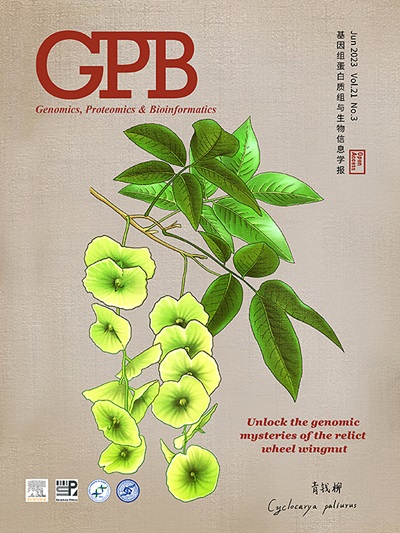人畜共患病寄生虫弓形虫的蛋白质乳化和代谢调节。
IF 7.9
2区 生物学
Q1 GENETICS & HEREDITY
引用次数: 0
摘要
弓形虫是最普遍的寄生虫病之一(弓形虫病)的致病病原体,但人们对弓形虫的生物学特性仍然知之甚少。葡萄糖代谢产生的乳酸不仅是包括弓形虫在内的多种生物的能量来源,也是参与基因激活和蛋白质功能的调节分子。赖氨酸乳化(Kla)是一种翻译后修饰(PTM),最近被认为与染色质重塑有关。为了研究乳化作用在淋病双球菌寄生虫中的普遍性和功能,我们绘制了增殖速虫细胞的乳化组图谱,并在淋病双球菌 RH 株的 955 个蛋白质上鉴定出了 1964 个乳化位点。乳化蛋白分布在多个亚细胞区,与多种生物过程密切相关,包括 mRNA 剪接、糖酵解、氨基酰-tRNA 生物合成、RNA 运输和许多信号通路。我们还使用乳化特异性抗体进行了染色质免疫沉淀测序(ChIP-seq)分析,发现组蛋白H4K12la和H3K14la富集在与微管运动和细胞侵袭相关的淋球菌启动子和外显子区域。我们进一步证实了组蛋白去乙酰化酶 TgHDACs 2、3 和 4 的脱乳活性,并发现用抗组蛋白乙酰转移酶(TgMYST-A)抗体处理能显著减少淋病双球菌的蛋白乳化。这项研究首次提供了全球乳化蛋白质组的数据集,为进一步剖析淋球菌的功能生物学提供了基础。本文章由计算机程序翻译,如有差异,请以英文原文为准。
Protein Lactylation and Metabolic Regulation of the Zoonotic Parasite Toxoplasma gondii
The biology of Toxoplasma gondii, the causative pathogen of one of the most widespread parasitic diseases (toxoplasmosis), remains poorly understood. Lactate, which is derived from glucose metabolism, is not only an energy source in a variety of organisms, including T. gondii, but also a regulatory molecule that participates in gene activation and protein function. Lysine lactylation (Kla) is a type of post-translational modifications (PTMs) that has been recently associated with chromatin remodeling; however, Kla of histone and non-histone proteins has not yet been studied in T. gondii. To examine the prevalence and function of lactylation in T. gondii parasites, we mapped the lactylome of proliferating tachyzoite cells and identified 1964 Kla sites on 955 proteins in the T. gondii RH strain. Lactylated proteins were distributed in multiple subcellular compartments and were closely related to a wide variety of biological processes, including mRNA splicing, glycolysis, aminoacyl-tRNA biosynthesis, RNA transport, and many signaling pathways. We also performed a chromatin immunoprecipitation sequencing (ChIP-seq) analysis using a lactylation-specific antibody and found that the histones H4K12la and H3K14la were enriched in the promoter and exon regions of T. gondii associated with microtubule-based movement and cell invasion. We further confirmed the delactylase activity of histone deacetylases TgHDAC2–4, and found that treatment with anti-histone acetyltransferase (TgMYST-A) antibodies profoundly reduced protein lactylation in T. gondii. This study offers the first dataset of the global lactylation proteome and provides a basis for further dissecting the functional biology of T. gondii.
求助全文
通过发布文献求助,成功后即可免费获取论文全文。
去求助
来源期刊

Genomics, Proteomics & Bioinformatics
Biochemistry, Genetics and Molecular Biology-Biochemistry
CiteScore
14.30
自引率
4.20%
发文量
844
审稿时长
61 days
期刊介绍:
Genomics, Proteomics and Bioinformatics (GPB) is the official journal of the Beijing Institute of Genomics, Chinese Academy of Sciences / China National Center for Bioinformation and Genetics Society of China. It aims to disseminate new developments in the field of omics and bioinformatics, publish high-quality discoveries quickly, and promote open access and online publication. GPB welcomes submissions in all areas of life science, biology, and biomedicine, with a focus on large data acquisition, analysis, and curation. Manuscripts covering omics and related bioinformatics topics are particularly encouraged. GPB is indexed/abstracted by PubMed/MEDLINE, PubMed Central, Scopus, BIOSIS Previews, Chemical Abstracts, CSCD, among others.
 求助内容:
求助内容: 应助结果提醒方式:
应助结果提醒方式:


